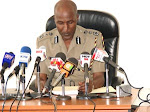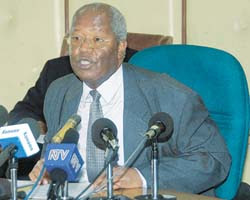 First they sent leaflets saying they would avenge the killings of their tribesmen when violence flared following Kenya's disputed election. Then they told other tribes to leave certain areas. People's fears had come true. The Mungiki were back.
First they sent leaflets saying they would avenge the killings of their tribesmen when violence flared following Kenya's disputed election. Then they told other tribes to leave certain areas. People's fears had come true. The Mungiki were back.
Hundreds of men wielding machetes and clubs, attacked their opponents beheading and dismembering them in characteristic style.
"We received leaflets warning us to leave or die" Amunga
The violence has largely abated for now, as politicians negotiate their way towards a political settlement, but the re-emergence of this quasi-religious group could plague Kenya for years to come.
The Mungiki has been outlawed by the authorities, with whom it has been engaged in a protracted battle spanning more than 20 years.
At first they styled themselves as the guardians of Kenya's largest community, the Kikuyu who include President Mwai Kibaki among their number, saying they would re-establish ancient traditions. Attracting large numbers of jobless teenagers, the group soon became an underground youth wing for politicians who used it to unleash terror on their political opponents.
Attracting large numbers of jobless teenagers, the group soon became an underground youth wing for politicians who used it to unleash terror on their political opponents.
Mungiki thus became a criminal gang terrorising urban slums and demanding protection money from transport operators.
"We received leaflets warning us to leave or face death," Amunga, a resident of a town in central Kenya told the BBC.
"They said they would behead anyone who supported the opposition. They gave us just seven days to leave."
Amunga says those threats prompted hundreds of people to flock to police stations for refuge.
Rival militia
To counter the Mungiki, residents in the informal settlements formed their own vigilante groups, saying the police had failed to deal with the threat.
One notorious gang is the equally dreaded Taliban which draws membership from the Luo community - who largely back the opposition.
Another militia known as the Sabaot Land Defence Force (SLDF) is now harrassing locals on the foot of Mount Elgon in western Kenya.
The SLDF is composed of members of the Sabaot, a sub-tribe of the Kalenjin community. In the past it was fighting over land with rival clans.
Unlike the Mungiki and the Taliban, which are largely urban based, the SLDF operates in rural areas and has even established a parallel administration system in the Mount Elgon district.
For funding, the group imposed a tax on residents and raided villages for supplies.
The SLDF is now reported to be attacking neighbouring communities.
Its members are normally armed with assault rifles and have been accused of killing more than 400 people. Re-emergence
Re-emergence
Before the elections, police vowed to eliminate the Mungiki once and for all.
At one point human right organisations accused the police of executing more than 500 members of the group.
Although the police denied the accusation, the recovery of hundreds of bullet-ridden bodies on the outskirts of Nairobi, made some think the Mungiki had at last been wiped out.
But the post-election violence appears to have breathed new life into this group.
Their re-emergence followed the killing of hundreds of Kikuyu in opposition strongholds in western Kenya.
The Mungiki scented blood and wanted vengeance.
Soon Mungiki gangs attacked other tribes and hacked them to death.
It is not clear who finances the Mungiki, although it has been suggested they are in the payroll of some politicians.
Recently the Mungiki have been confronting women wearing trousers forcing them to change into skirts or long dresses.
They say wearing trousers goes against the Kikuyu culture.
It is feared that if the electoral crisis persists, the gangs could become even more dangerous.
Monday, February 11, 2008
Kenyan militia strike back
Posted by
Kenyan Revelations
at
5:16 PM
![]()
![]()
Labels: Goons for Hire
Subscribe to:
Comment Feed (RSS)















|